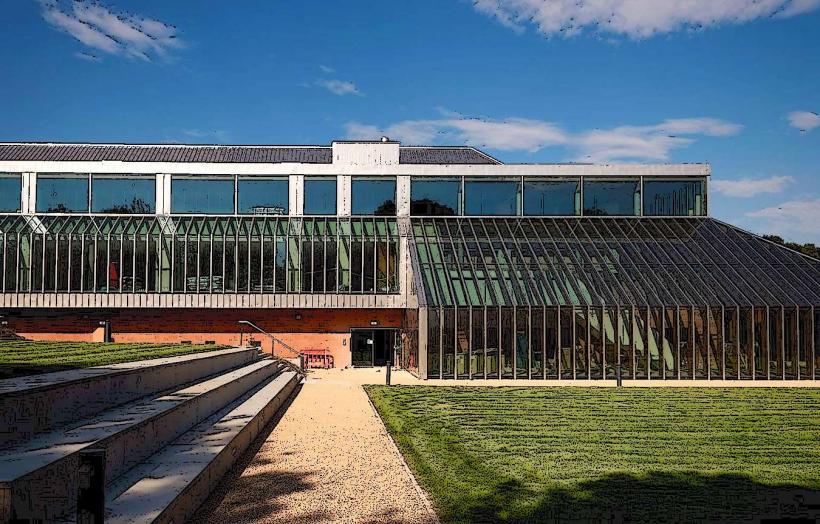Information
Landmark: Glasgow School of ArtCity: Glasgow
Country: United Kingdom
Continent: Europe
The Glasgow School of Art (GSA) is one of the most renowned and influential art schools in the United Kingdom, known for its innovative teaching, pioneering architecture, and its long history of shaping Scotland's artistic and creative landscape. Located in the city center of Glasgow, the school has built a reputation as a hub for contemporary art, design, and architecture education, and has produced numerous influential artists, designers, and architects over its more than 170-year history.
Here is a detailed exploration of the Glasgow School of Art, its history, significance, key features, and impact on the arts and education:
History and Origins
Founding and Early Years:
- The Glasgow School of Art was founded in 1845 as a response to the growing need for formal art education in Glasgow, which was undergoing rapid industrialization during the 19th century. It was established by a group of prominent Glaswegian industrialists, including John M. Kirkman and William West.
- Initially, the school offered classes in subjects such as drawing, painting, and design, with a focus on craftsmanship and the development of technical skills. Over the years, the school adapted to the evolving demands of the art world, introducing new courses and programs in fields such as graphic design, architecture, and fine arts.
Architectural Evolution:
- One of the key milestones in the history of the Glasgow School of Art is the construction of its iconic building on Renfrew Street, designed by renowned Scottish architect Charles Rennie Mackintosh. The school’s main building, known as the Mackintosh Building, is considered one of the most important and influential works of Arts and Crafts architecture and a masterpiece of modernist design.
- The Mackintosh Building, completed in 1909, combines elements of Art Nouveau, Japanese design influences, and Arts and Crafts principles, and remains one of the most celebrated examples of Scottish architecture. The building is a UNESCO-recognized design gem, and its integration with the surrounding environment was groundbreaking at the time.
Expansion and Growth:
- Over the years, the Glasgow School of Art continued to evolve, expanding its curriculum and incorporating more contemporary design and art education practices. By the mid-20th century, the school had developed a reputation for excellence in industrial design, architecture, and visual arts.
- In the latter half of the 20th century, the GSA became known for fostering creativity and artistic experimentation, and its graduates began to gain recognition in the global art world. The school’s focus on providing a stimulating environment for its students to experiment with new ideas and media helped solidify its place as a leading institution for the arts in the UK.
The Mackintosh Building
Design and Architecture:
- The Mackintosh Building is widely regarded as the heart of the Glasgow School of Art, both in terms of its architectural importance and its role as the physical space where generations of students have learned and developed their artistic skills.
- The building’s design is characterized by its unique blend of elegant geometry, natural light, and high-quality craftsmanship. The distinctive use of materials, including timber, glass, and steel, along with artistic details like stained glass windows, decorative panels, and ironwork, makes the Mackintosh Building a key part of Glasgow’s architectural heritage.
- The main hall, with its high ceilings and intricate woodwork, and the library, which is considered one of the most beautiful and atmospheric library spaces in the world, are just a few examples of the building’s remarkable design.
Artistic Influence:
- Charles Rennie Mackintosh, who was both the architect and interior designer, infused the building with his distinctive style. His work combines elements of Scottish symbolism, art nouveau, and early modernism, drawing on a range of influences from Japanese art and European decorative movements.
- Mackintosh’s contributions to the GSA are so integral to the school’s identity that they continue to inspire students and visitors alike. The building itself remains a living, breathing testament to the innovative ideas of one of Scotland’s greatest architects.
Educational Programs
The Glasgow School of Art offers a wide range of undergraduate and postgraduate programs across different disciplines, all aimed at providing students with the technical skills, creativity, and critical thinking abilities required for a successful career in the arts. Here’s an overview of the key educational programs:
Undergraduate Courses:
- Fine Art: This program covers various artistic disciplines, including painting, sculpture, printmaking, digital art, and installation art. Students are encouraged to develop their own unique creative voice while gaining a solid grounding in the techniques and theories that underpin contemporary fine art practices.
- Architecture: One of the school’s most prestigious programs, the architecture course focuses on innovative design principles, sustainability, and the role of architecture in society. The course combines theoretical studies with practical design skills, and students are encouraged to experiment with new materials and technologies.
- Product Design: Students in this program focus on designing functional and aesthetically pleasing products, with an emphasis on user-centered design and sustainability. This course has produced many graduates who have gone on to become influential designers in the product and industrial design fields.
- Graphic Design: This course explores the visual aspects of communication, teaching students to use design principles to solve problems and create impactful graphics for a variety of media, including print, digital platforms, and motion graphics.
- Fashion: The fashion program focuses on both creative and technical aspects of fashion design, equipping students with the skills needed to create original designs, understand textile materials, and work within the global fashion industry.
Postgraduate and Research Programs:
- The GSA offers a variety of postgraduate courses, including Master’s and PhD programs in fine arts, design, and architecture. These programs allow students to engage in more specialized and experimental areas of study, with a focus on pushing the boundaries of artistic practice and research.
- The postgraduate programs emphasize independent research, enabling students to contribute to ongoing conversations within their disciplines and engage with global artistic communities.
Impact and Influence
Global Reputation:
- The Glasgow School of Art has earned a reputation as one of the top art and design schools in the UK and Europe. Its commitment to innovative education, combined with its emphasis on developing students’ critical thinking and creativity, has made it a sought-after institution for aspiring artists, designers, and architects.
- Graduates from GSA have gone on to achieve great success in the art world, with alumni working in a variety of fields, including visual arts, graphic design, product design, architecture, fashion, and film. Many have become internationally acclaimed figures in their respective fields, contributing to the school’s legacy and global standing.
Notable Alumni:
- The Glasgow School of Art has produced many influential figures in the art and design world, including Charles Rennie Mackintosh (architect and designer), Margaret Macdonald Mackintosh (artist and designer), and Alison Watt (painter).
- Other notable alumni include David Shrigley (artist), Douglas Gordon (video artist), and Steven Holl (architect). These individuals have had a profound impact on the global art scene, demonstrating the school’s ability to nurture and support creative talent.
Cultural and Artistic Hub:
- In addition to its educational programs, the Glasgow School of Art is an important cultural institution in Glasgow. The school regularly hosts exhibitions, lectures, workshops, and events, often open to the public, which promote artistic exchange and engagement with the community.
- The Mackintosh Building and other facilities within the school are often used to host exhibitions by both students and established artists. This helps keep the school at the forefront of artistic innovation and ensures that it continues to engage with the broader art world.
Challenges and Recovery
Fire Damage:
- In 2014, the Glasgow School of Art suffered a devastating fire that caused significant damage to the Mackintosh Building. The fire destroyed much of the building’s interior, including many of its iconic features. The fire’s impact on the building was felt deeply, as it was one of the most important examples of Scottish architectural heritage.
- However, the GSA has been working on an ambitious restoration project to rebuild and preserve the Mackintosh Building. The project aims to restore the building to its former glory while ensuring that it meets modern building standards and continues to serve as a vibrant space for learning and creativity.
Community and Artistic Resilience:
- Despite the challenges posed by the fire, the Glasgow School of Art has shown resilience, continuing its work in other parts of the city and maintaining its position as a leading institution for art education.
- The restoration of the Mackintosh Building is seen as a symbol of the school’s commitment to preserving its artistic and architectural heritage while looking to the future.
Conclusion
The Glasgow School of Art is a cornerstone of Scotland’s artistic and creative legacy, with a rich history of producing innovative work in art, design, and architecture. Its focus on creativity, critical thinking, and innovative design continues to inspire new generations of students and artists. With its iconic Mackintosh Building, a remarkable educational legacy, and a growing influence on the global arts scene, the GSA remains a beacon of artistic excellence and an integral part of Glasgow’s cultural fabric.










